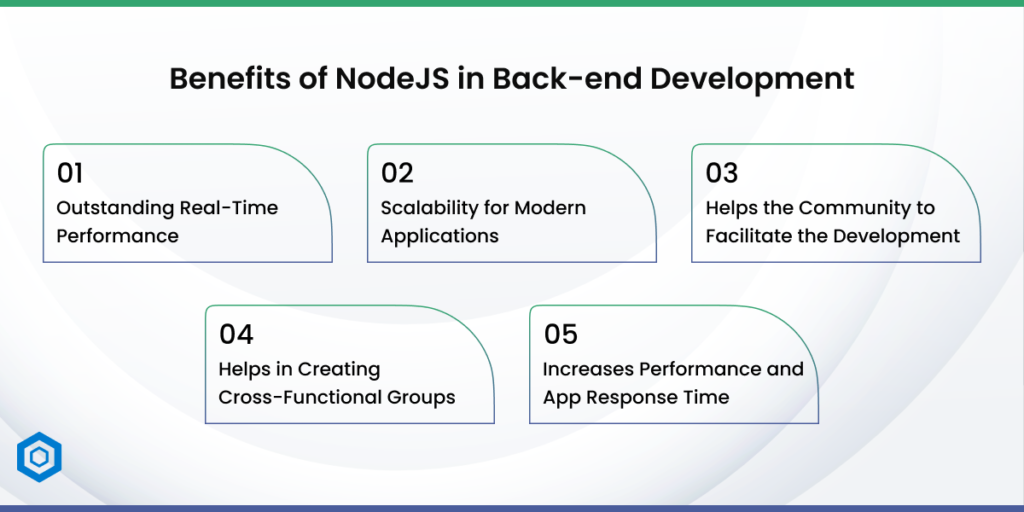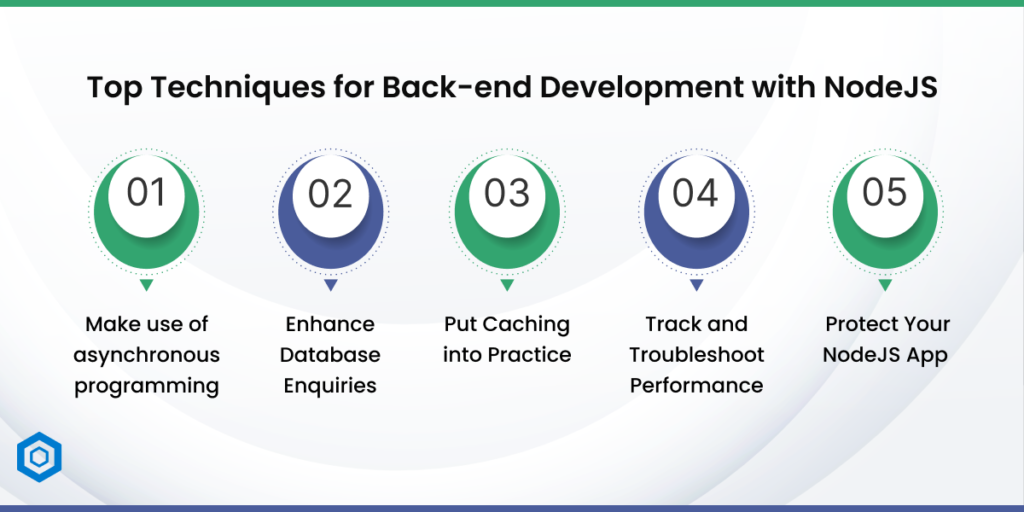
NodeJS for Back-end Development | Top Benefits & Features
01 NOVEMBER
NodeJS has become a potent tool and a popular development among developers. Thanks to its unique features and benefits, it has completely changed how web apps are developed. This blog will discuss the advantages of NodeJS for Back-end Development and why so many developers now choose it.
NodeJS for Back-end Development has emerged as the next technological trend. NodeJS is a much more efficient and user-friendly backend than any other framework, tool, or library.
What is NodeJS?
Based on the V8 JavaScript code found in Chrome, NodeJS is a popular cross-platform runtime environment. Ryan Dahl first presented it in 2019. With this open-source platform, developers can create real-time web applications.
The non-blocking asynchronous architecture and functionalities of NodeJS have contributed significantly to its popularity. The advantages of NodeJS for online apps are being utilized by industry titans such as Uber, Netflix, Walmart, and eBay. It dramatically streamlines and expedites the web development process.
Based on the V8 JavaScript code found in Chrome, NodeJS is a popular cross-platform runtime environment. Ryan Dahl first presented it in 2019. With this open-source platform, developers can create real-time web applications.
The non-blocking asynchronous architecture and functionalities of NodeJS have contributed significantly to its popularity. The advantages of NodeJS for online apps are being utilized by industry titans such as Uber, Netflix, Walmart, and eBay. It dramatically streamlines and expedites the web development process.

Benefits of NodeJS in Back-end Development
According to the NodeJS 2018 User Survey, over 85% of online app users use Javascript.
- Outstanding Real-Time Performance
Multitasking is quite beneficial for NodeJS web apps. In contrast to other platforms, its single-threaded, event-driven architecture efficiently handles several concurrent requests without using too much RAM.
Additionally, because of its event-loop and non-blocking I/O operations, code can be executed at a rate that substantially impacts the application’s overall performance. Google’s V8 benchmark aims to increase NodeJS speed by utilizing better compilers, quicker execution, scalability, and security patchwork. - Scalability for Modern Applications
Among the many elements of cutting-edge technology is the cluster module. Load balancing over many CPU cores allows for efficient achievement of desired effects with smaller modules without consuming all the RAM.
NodeJS’ non-blocking event-loop technology scales well and speeds up server responses. - Helps the Community to Facilitate the Development
Given that the NodeJS community comprises millions of active developers, we can anticipate substantial support from development specialists worldwide to address even the most unusual development difficulties.
NPM includes several tools and libraries we can use immediately for our project. Developer-created resources, including ready-to-use solutions, programs, modules, libraries, and registries, may be found on GitHub to help us accomplish more tasks with less effort.
The support of this active community from several major IT companies, including Amazon, Google, Facebook, and Netflix, further amplifies the benefits of NodeJS. As a result of their efforts, many open-source solutions have been developed. The development community’s and tech giants’ acceptance has ensured technology’s continued existence and expansion in the foreseeable future. - Helps in Creating Cross-Functional Groups
Full-stack development capabilities offered by NodeJS enable us to swiftly address issues and build a team dedicated to enhancing our development life cycle. Higher productivity is encouraged in this workplace, allowing us to identify and address problems appropriately. - Increases Performance and App Response Time
NodeJS’s single-threaded event-loop paradigm uses fewer resources and generates fewer threads while offering a non-blocking asynchronous design. This enables our program to support multiple concurrent users, improving its responsiveness.
The best-performing use cases
Well-known businesses developed the backend of their software products using NodeJS. Here are a few of the most effective usage cases:
- LinkedIn
LinkedIn moved to NodeJS in 2011. During that period, the business encountered problems using Ruby to process several requests simultaneously. Besides, the pages were slow to load because the Ruby program operated synchronously.
The decision to move to NodeJS has been made to improve the app’s performance and lower resource consumption. This technological advancement made the transition from a synchronous to an asynchronous system possible. Consequently, the application’s scalability and performance improved. - Netflix
Netflix used JavaScript on the front end and Java for the back end until 2015. The load speed was high because of the rocky server-side to client-side transition. Consequently, end-user latency was frequently seen.
In addition, as the client base began to develop quickly, the application’s monolithic nature made scaling the program nearly impossible.
NodeJS reduced startup time by 70%. The shift from server-side to client-side was greatly enhanced because NodeJS is a backend Javascript technology. - Paypal
PayPal had problems switching from Java to JavaScript, much like Netflix did. They caused issues with payment processing and decreased loading time.
Additionally, Java’s significant environmental dependencies had a detrimental effect on PayPal’s productivity.
When NodeJS was adopted in 2013, Paypal pages loaded 35% more quickly. The response time also significantly decreased. Furthermore, the NodeJS application has double the capacity to process requests in a second.
NASA, Uber, Yahoo, Medium, Walmart, and Twitter are well-known companies utilizing Node.
Comparison with other technologies
Let’s now talk about how NodeJS differs from other back-back programming languages.
- NodeJS vs. Java
Java and NodeJS both execute applications within their own environments. However, the parallels between these two technologies stop there.
NodeJS is built on non-complied languages like JavaScript, while Java is an object-oriented, compiled programming language. As a result, the use of NodeJS cases is entirely different.
Java’s thread pool makes it a practical choice for complex computations, whereas NodeJS is useful for I/O applications. To further understand how NodeJS compares with other technologies, check out this detailed comparison of NodeJS vs PHP. - Python vs. NodeJS
NodeJS may be used to develop cloud and Internet of Things solutions and online and mobile applications.
Python is a universal language that helps in developing many desktop and web applications, but it is not very useful for creating mobile apps.
Scalability results for Python and NodeJS are not the same. Many people utilize NodeJS to create scalable applications. At the same time, scalability can become a problem with Python. The Python system is becoming too complicated to manage as it expands.

NodeJS for Back-end Development: Top Techniques to Master
Use these best practices to make sure your NodeJS backend apps run as smoothly and robustly as possible:
- Make use of asynchronous programming
Use asynchronous programming strategies, such as callbacks, promises, or async/await, to enhance application responsiveness and prevent event loop blocking. - Enhance Database Enquiries
Optimize your database queries to increase application performance and reduce response times. Avoid pointless searches, use the proper indexes, and consider implementing caching methods. - Put Caching into Practice
Use caching techniques to lessen the strain on your backend and save frequently accessed data. To increase performance, use caching libraries like Redis or Memcached. - Track and Troubleshoot Performance
Use logging and monitoring tools to find and fix performance problems. You can monitor and improve your application’s performance with PM2 or New Relic tools. - Protect Your NodeJS App
Use best practices to shield your application against typical security flaws, like data sanitization, input validation, and authentication and authorization systems.
Conclusion
NodeJS is an excellent tool for creating scalable and effective web apps. Our developers and the companies we work with love using NodeJS. It offers the ideal balance of speed, size, and performance, opening up use cases essential to web projects.
Using NodeJS can significantly improve our applications. We hope this blog has helped you understand NodeJS’s key features, significance, and use in software development projects.
Additionally, Codeflash Infotech provides the best NodeJS development service, including software development, artificial intelligence, machine learning, data science, and business analytics.
Frequently Asked Questions
Because of its non-blocking I/O style, NodeJS performs exceptionally well while managing high traffic volumes and concurrent connections.
Creating real-time apps like chat rooms or streaming services is a good fit for NodeJS.
NodeJS is compatible with several databases, such as PostgreSQL, MySQL, and MongoDB.
Compared to competing technologies, NodeJS uses fewer resources to manage the same traffic volume, making it a cost-effective alternative.





